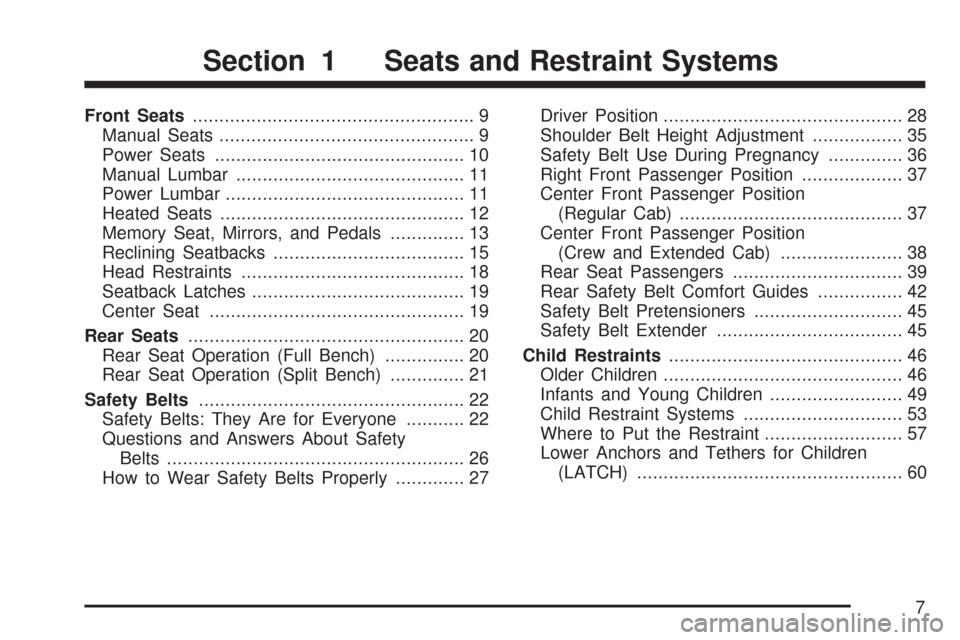Page 7 of 684

Front Seats..................................................... 9
Manual Seats................................................ 9
Power Seats............................................... 10
Manual Lumbar........................................... 11
Power Lumbar............................................. 11
Heated Seats.............................................. 12
Memory Seat, Mirrors, and Pedals.............. 13
Reclining Seatbacks.................................... 15
Head Restraints.......................................... 18
Seatback Latches........................................ 19
Center Seat................................................ 19
Rear Seats.................................................... 20
Rear Seat Operation (Full Bench)............... 20
Rear Seat Operation (Split Bench).............. 21
Safety Belts.................................................. 22
Safety Belts: They Are for Everyone........... 22
Questions and Answers About Safety
Belts........................................................ 26
How to Wear Safety Belts Properly............. 27Driver Position............................................. 28
Shoulder Belt Height Adjustment................. 35
Safety Belt Use During Pregnancy.............. 36
Right Front Passenger Position................... 37
Center Front Passenger Position
(Regular Cab).......................................... 37
Center Front Passenger Position
(Crew and Extended Cab)....................... 38
Rear Seat Passengers................................ 39
Rear Safety Belt Comfort Guides................ 42
Safety Belt Pretensioners............................ 45
Safety Belt Extender................................... 45
Child Restraints............................................ 46
Older Children............................................. 46
Infants and Young Children......................... 49
Child Restraint Systems.............................. 53
Where to Put the Restraint.......................... 57
Lower Anchors and Tethers for Children
(LATCH).................................................. 60
Section 1 Seats and Restraint Systems
7
Page 28 of 684

Driver Position
Lap-Shoulder Belt
The driver has a lap-shoulder belt. Here is how to
wear it properly.
1. Close and lock the door.
2. Adjust the seat so you can sit up straight. To
see how, see “Seats” in the Index.3. Pick up the latch plate and pull the belt across
you. Do not let it get twisted.
The lap-shoulder belt may lock if you pull the
belt across you very quickly. If this happens,
let the belt go back slightly to unlock it.
Then pull the belt across you more slowly.
4. Push the latch plate into the buckle until it
clicks.
Pull up on the latch plate to make sure it is
secure. If the belt is not long enough,
seeSafety Belt Extender on page 45.
Make sure the release button on the buckle is
positioned so you would be able to unbuckle
the safety belt quickly if you ever had to.
5. Move the shoulder belt height adjuster to the
height that is right for you. Improper shoulder
belt height adjustment could reduce the
effectiveness of the safety belt in a crash. See
Shoulder Belt Height Adjustment on page 35.
28
Page 35 of 684
To unlatch the belt, push the button on the buckle.
The belt should go back out of the way.
Before you close the door, be sure the belt is out
of the way. If you slam the door on it, you can
damage both the belt and your vehicle.
Shoulder Belt Height Adjustment
Shoulder belt height adjusters are available for the
driver and right front passenger seating positions.
Before you begin to drive, move the shoulder
belt adjuster to the height that is right for you.
Adjust the height so that the shoulder portion of
the belt is centered on your shoulder. The
belt should be away from your face and neck, but
not falling off your shoulder. Improper shoulder
belt height adjustment could reduce the
effectiveness of the safety belt in a crash.
To move the adjuster
down for the regular
and crew cabs, squeeze
the buttons (A) on the
sides of the height
adjuster and move the
height adjuster to
the desired position.
Regular and Crew Cab
35
Page 532 of 684

If you have rear drum brakes, they do not have
wear indicators, but if you ever hear a rear brake
rubbing noise, have the rear brake linings
inspected immediately. Rear brake drums should
be removed and inspected each time the tires
are removed for rotation or changing. Drum brakes
have an inspection hole to inspect lining wear
during scheduled maintenance. When you have
the front brake pads replaced, have the rear
brakes inspected, too.
Brake linings should always be replaced as
complete axle sets.
Brake Pedal Travel
See your dealer/retailer if the brake pedal does
not return to normal height, or if there is a
rapid increase in pedal travel. This could be a sign
that brake service might be required.
Brake Adjustment
Every time you make a brake stop, the brakes
adjust for wear.
Replacing Brake System Parts
The braking system on a vehicle is complex. Its
many parts have to be of top quality and work well
together if the vehicle is to have really good
braking. Your vehicle was designed and tested
with top-quality brake parts. When you replace
parts of the braking system — for example, when
the brake linings wear down and you need
new ones put in — be sure you get new approved
replacement parts. If you do not, the brakes
might not work properly. For example, if someone
puts in brake linings that are wrong for your
vehicle, the balance between the front and rear
brakes can change — for the worse. The braking
performance you have come to expect can
change in many other ways if someone puts in the
wrong replacement brake parts.
532